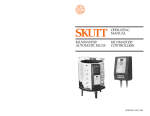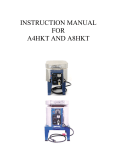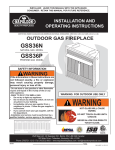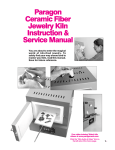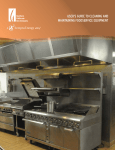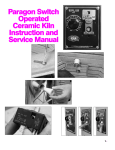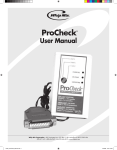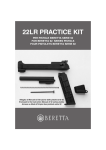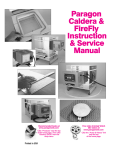Download Paragon MagicFuse Microwave Kiln Instruction & Service Manual
Transcript
Paragon MagicFuse Microwave Kiln Instruction & Service Manual Introduction Thank you for buying a Paragon MagicFuse kiln. You are about to begin an adventure in creativity. Use the MagicFuse to make fused glass jewelry of your own design. The MagicFuse uses advanced technology to fuse glass at spectacular speeds—all inside a common microwave oven. Mastering this kiln requires practice and patience. Please begin by reading the manual. The information here will save you much time and is based on our own testing. Follow the manual and learn to control the heat to achieve precise fusing results. The two most common firing errors are breaking and over-firing the glass. The manual will show you how to avoid those errors by pre-heating the glass and checking it visually. Checking the glass visually. To expand your knowledge of glass, visit www.paragonweb.com and select “Products,” then “Books & DVDs” from the drop menu. You will find a wide selection of recommended books that you can purchase from your favorite reseller. Paragon makes a large selection of electric glass kilns for the hobbyist and professional. To make larger or more intricate pieces or to fire production loads of glass, please see our kilns at www.paragonweb.com. You are about to enter the magical world of accelerated high temperature glass firing. To safely find your way around, read this manual. Save for future reference. We wish you much success in glass fusing. IM-240/10-08 ©2008, by Paragon Industries, L.P. -2- Packed with the MagicFuse Kiln top Safety Rules I I Kiln base 6 - ½" ceramic posts Glass separator Instruction manual Other Supplies Needed Microwave oven with metal interior that is at least 8" tall inside 12" x 12" ceramic tile, ceramic kiln shelf, or other heat-proof surface I I Heat-resistant gloves 1" paint brush for applying glass separator Notebook for keeping firing records I Glass cutter I Clear safety glasses MagicFuse Kiln Specifications Interior: 4 ½" diameter firing surface x 1 ½" high Exterior: 7" wide x 4" high 1" thick ceramic fiber walls Maximum temperature 1650°F / 898°C I Do not use extension cords with the microwave. Wear clear safety glasses whenever visually checking the glass in a hot kiln. It is possible for hot glass to break apart and fly out of the kiln during firing and cooling. Stay at arm's length from the kiln when you lift the top to check hot glass. Wear safety glasses when visually checking the glass in the kiln. Fire only glass in the MagicFuse. Do not fire marbles, precious stones, ceramics, combustible materials, or metal inside the kiln. These materials can explode due to the very rapid heating rate. Fire only fusing-compatible glass, which is available from art glass suppliers. Incompatible glass will break, sometimes weeks after the piece is fired. Wear heat-protective gloves when removing the hot kiln from the microwave oven. Hold the kiln top and base with both hands. Remove the kiln from the microwave oven immediately after the firing is finished. Do not allow the kiln to cool inside the microwave. Remove the kiln right after the firing is finished. Wear heat-protective gloves. -3- -4- I I I I I I I I I Cracks in the Kiln Place the hot kiln on a heat-proof surface after you remove it from the microwave. Place 3 - ½" ceramic posts under the kiln to separate it from the heat-proof surface. Small cracks will appear inside the kiln after you have fired it several times. Do not be concerned with these. They are normal and do not affect the firing results. The kiln will make plinking noises as it cools. This is also normal and nothing to be concerned about. Do not place a hot kiln under an overhead cabinet. Keep the hot kiln 8" away from any combustible surface. Do not over-fire the kiln. Over-firing will damage the kiln and is not covered by warranty. If you are not sure how long to fire, then under-fire and gradually increase the firing time. After removing the kiln from the microwave, leave the kiln closed for at least 45 minutes. Do not fire the kiln again until it has cooled at least 45 minutes since the last firing. When opening the kiln after it has cooled, lay the kiln top upside-down on a heat proof surface. Placing the top with the open face down against the heat-proof surface may cause heat to build up. Do not leave the kiln unattended around children or pets. The kiln interior can reach well over 1650°F (898°C)! Turn off the microwave if you see sparking inside. Avoid breathing dust from glass separator or ceramic fiber paper. You can fuse painted glass (using paint designed for glass fusing, available from art glass suppliers.) Painted glass may produce fumes, so operate in a well-ventilated area. Consult your art glass supplier for more details. -5- The Microwave Oven To fire your new MagicFuse kiln, you will need a microwave oven with metal interior that is at least 8" tall inside. After firing the kiln, you can still cook food in the microwave. But you should clean it first. (See your microwave manual for cleaning instructions.) Note: Some older microwave ovens are not able to fire the kiln. If the kiln does not get hot, try a newer microwave. Some microwave ovens heat the glass unevenly. In this case, try a different microwave, or fire only one piece of glass at a time. Basic Glass Cutting Caution: Always wear clear safety glasses while cutting glass. Small slivers of glass can become airborne. Lay the glass on a clean, flat surface. Mark off the cut with a grease pencil at each end of the glass. Lay a straight edge over the glass and line it up with the marks you just made. Hold the straight edge firmly and score the glass with a quality glass cutter (preferably one with an oil reservoir). Hold the cutter vertically and not slanted. Press hard enough so that the scoring noise sounds steady and unbroken. But don't press harder than you need to. Place the straight edge under the glass so that an edge of the straight edge is lined up with the score line you just made. Press down on the glass to break it on the score line. -6- Note: A quality glass cutter with oil reservoir, available from art glass suppliers, is much easier to use than the inexpensive cutters sold in hardware stores. A good cutter will save enough glass to pay for itself. A Fast Way to Cut Small Pieces First make all your score lines on the glass. Then turn the glass over and tap out the pieces. This is an easy, fast way to cut many pieces. Glass Fusing Before assembling glass pieces, clean them with water or alcohol to remove fingerprints and dirt, which may otherwise become permanently etched into the fired glass. A greasy fingerprint can also cause the glass to break during firing. Do not glue the glass pieces that you Clean the glass before firing. are about to fire. Glue between layers of glass increases the chance of breakage. Because the kiln fires so rapidly, glue doesn't have time to burn out completely and discolors the glass, especially dichroic. Coat the circular firing area of the kiln base with glass separator. This prevents hot glass from sticking to the base. Apply 2 - 3 thin coats with a brush, and dry before firing the kiln. Follow instructions on the glass separator package. Note: For pieces larger than 1" or for See your microwave manual for instructions on reducing the power to 50%. Sometimes a finished glass piece is underfired and needs additional fusing. After layers of glass have been fused together, the glass becomes one thick mass and is more likely to break from heat shock if fused a second time in the MagicFuse. However, you can usually succeed with a second firing if you pre-heat the piece at 40 - 50% for 5 - 10 minutes. Fire fusing-compatible glass purchased from an art glass supplier. The glass that you fuse together must be rated to the same coefficient of expansion (COE). A piece made from glasses of different COE ratings will likely break as it cools. Your supplier can give you the COE rating of your glass (usually 90 or 96). -7- rately in clearly marked containers, or use glass of only one COE rating. Protect the Base with Glass Separator The maximum size of glass fired in the MagicFuse is 2" square, and the maximum thickness is 2 layers of 18 " or 4 layers of 161 ". Two layers of 18 " x 1" x 1 ½" is a good average size. Larger or thicker projects may break from heat shock due to the very fast firing rate. You can successfully fuse dichroic glass in the MagicFuse. more than 2 layers, pre-heat the glass at 50% power for 5 minutes. See your microwave instruction manual for adjusting the power. Note: Glass of different COE ratings must be stored sepa- Drying the glass separator with a hair dryer. Sand off a damaged coat of glass separator before applying a new coat. Note: You can dry the glass separator with a hair dryer or place the kiln base inside an oven at 200°F (90°C). -8- Apply more glass separator to areas where the coating flakes off or cracks with use. Gently sandpaper the base and apply another coat. Note: Before applying a new coat of glass separator, remove only enough of the old separator to smoothen the surface. It is not necessary to remove all the separator. Shelf paper, sold by art glass suppliers, does the same thing as shelf separator: It prevents the glass from sticking to the kiln base. The shelf paper is placed between the glass and the kiln base. But if you use glass separator, you do not need shelf paper. Some brands of shelf paper produce an odor. For this reason Shelf paper under the glass. we recommend only glass separator when working in a kitchen area. Note: Even if you use shelf paper, the kiln base still needs a coating of glass separator. Position the Kiln Inside the Microwave Firing the kiln on the microwave's food rotator tray produces better heat distribution inside the kiln. However, in some microwaves the rotator tray jerks as it turns, moving glass pieces out of position. If this is a problem with your microwave, either use a different microwave, or remove the rotator tray and rollers from the microwave. If you cannot Removing the rotator tray and rollers. remove the rotator parts, then turn the rotator tray upside-down, and place 3 of the ½" ceramic posts that came with your kiln on the tray. If there is enough space, it may also be possible to remove the tray and place the posts in the bottom of the microwave near the rotator parts. -9- Note: Clean the rollers and area under the rotator tray for the smoothest rotation. Note: Always position 3 - 1/2" posts under the kiln inside the microwave oven. The posts prevent the kiln from overheating the bottom of the microwave. Clean the rollers and track for the smoothest rotation of the tray. The Firing Time All microwave ovens fire differently. The firing time varies from one microwave to the next, and a kiln that is still warm from a previous firing takes less time to fire than a cold kiln. A fluctuation in voltage can also change the firing time. Five minutes is the recommended minimum firing time. Use a reduced power setting on your microwave if it fires in less time than 5 minutes. This will lengthen the firing time to give you finer control. See the microwave manual for instructions on reduced heat settings. The easiest way to fire the kiln is to fire a glass piece in several stages, visually checking the glass at each stage. Each time you visually check the Left to right: tack fuse, medium fuse, and full fuse. glass, fire 30 - 60 seconds longer until the glass has fused to your satisfaction. Start out underfiring a test piece, and gradually add more firing time. Note: The glass begins to fuse during the last 30 seconds of firing. This is why precise fusing is much easier with visual inspection of the glass. Keep a detailed firing logbook to record the firing times for each type of project. Write down the following: Date Type of microwave oven Brand, color, and size of glass -10- Pre-heating time, if any, and pre-heat microwave power setting Power setting during firing Position the kiln base on top of the posts so the base is centered inside the microwave. Place the kiln body on top of the base. Firing time Whether the kiln was still warm from the previous firing Firing results and what you learned from the firing Suggested Firing Times These times are approximate and are based on the microwave oven wattage. 800 watts: 6 minutes 1000 watts: 5 minutes 1200 watts: 4 minutes (Remember, use a reduced power setting when the firing time is under 5 minutes.) Fire the Kiln Fire the Kiln Close the microwave door gently to avoid jarring the glass inside the kiln. Until you know how long to fire the kiln, start out under-firing the glass. Set the timer for 3 minutes or less. Turn on the microwave oven. Open the microwave door when the timer goes off. Leave the kiln inside the microwave. Wearing heat-protective gloves and clear safety glasses, lift the kiln top about an inch and check the glass. Look for only a second or two. Lower the kiln top. Preparation Before firing the kiln, make sure the glass separator that you applied to the base has dried. Decide where you will place the hot kiln when you remove it from the microwave. Three ½" ceramic posts on a 12" x 12" ceramic tile or ceramic kiln shelf are good choices. The 3 ceramic posts will separate the hot kiln from the ceramic tile or shelf. The posts prevent heat from transferring to the table or counter surface under the tile. Caution: Avoid placing a hot kiln on Formica, wood, or plastic surfaces. Do not place the kiln on top of the microwave to cool. Load the Microwave Place 3 - ½" ceramic posts in the microwave. Center the glass you are firing on the kiln base. Wear safety glasses and stay at arm’s length when checking the glass visually. Note: Wear safety glasses and stay at arm's length from the kiln (at least 15") whenever looking at the hot glass. If the glass needs to fire longer, close the microwave door, program another 30 - 60 seconds, and fire again. Then visually check the kiln again as in Step 3 above. Keep adding firing time and checking the glass until the glass is done. When the firing is completed, remove the kiln from the microwave wearing heat-protective gloves. -11- -12- Be careful to hold the kiln by the base. Keep the kiln top on the base so that heat does not escape the kiln. Note: The easiest way to figure the total firing time is to pro- gram a longer firing than is needed. Then subtract the time shown in the display at the end of the firing from the time entered at the beginning. Example: Enter 10 minutes at the beginning. The timer shows 4 minutes, 30 seconds when you remove the kiln from the microwave. 10 - 4 minutes, 30 seconds = 5 minutes, 30 seconds total firing time. Caution: Always remove the kiln after firing is finished. Leav- ing a hot kiln inside the microwave to cool would cause the microwave to overheat since the heat released from the kiln would build up in the enclosed space. Cooling the Kiln Place the kiln on top of 3 - ½" ceramic posts that are on a heat-proof surface such as a ceramic tile. Allow the kiln to cool for at least 45 minutes before lifting the kiln top. Caution: Do not speed up the cooling by lifting the kiln top Place 3 ceramic posts between the kiln or using a fan. Allow the closed and a heat-proof surface. kiln to cool for 45 minutes. Opening the kiln too soon could crack glass pieces from thermal shock. The larger the glass, the longer it takes to cool before opening the kiln. Note: While you wait for Sample Pendant Project After firing, the pendant is done. You do not need to glue a jewelry finding to the back, because the design includes a channel that is fused into the glass where you can string a cord or chain. Use glass that is rated fusing compatible. Note: This delicate pendant requires a microwave oven that does not vibrate during operation. Vibration will cause the top piece of glass to move out of place. It may be necessary to remove the microwave rotator tray. Cut 2 pieces of 34 " x 1 12 " glass. With scissors or razor blade, cut a strip of 18 " thick fiber shelf paper to form the channel for the cord or chain. Size: 18 " thick x 18 " wide x 1" long. Clean fingerprints from the glass. Then handle only by the edges. Lay the fiber paper across one piece of glass so that it is parallel with the 34 " side and 38 " from the edge. Gently lay the second piece of glass over the first. Sprinkle broken pieces of dichroic glass over the top piece of glass. the kiln to cool, cut and assemble the next pieces. Load the piece onto the MagicFuse kiln base. (The base must first be coated with glass separator.) When opening the kiln after it has cooled, lay the kiln top upside-down on a heatproof surface. Placing the top with the open face down against the heat proof surface may cause heat to build up. Place the warm top upside-down after removing the glass from the base. -13- Fire the glass until the glass pieces have fused together and the top piece has curled around the fiber paper scrap. Stop the firing before the dichroic glass flat- -14- tens into the surface. This particular piece should receive only a light-to-medium fuse. Sand until the interior is white to gray in color. Allow the kiln to cool for at least 45 minutes. Apply a new coat with a 1" paint brush. When the glass is cool enough to touch, remove the fiber paper with a tooth pick and thread a cord or chain into the channel. Glass Troubleshooter Points on the edges of the glass The glass was fired too hot. Grind the edges of the glass with a sheet of fine sandpaper or emery cloth. Lay the sandpaper on a flat surface and rub the glass over the sandpaper. Cracks Apply a second coating after 24 hours. Allow the kiln to dry completely before firing. Removing Embedded Glass from the Kiln Removing pointed corners from the The piece was too large or had too glass. many layers. Or you fired a piece a second time. Next time, fire smaller pieces, pre-heat the glass, or fire at a lower heat setting on your microwave oven. The glass was removed too soon from the kiln. Allow the glass to cool at least 45 minutes before lifting the kiln top and removing the piece. The glass pieces that fused together are incompatible. This means they expanded and contracted during firing at different rates. Buy glass that is rated fusing compatible from an art glass supplier. Hot glass can break during firing and fly against the kiln top and base. After the kiln cools, remove the embedded glass. If necessary, dig the glass out of the ceramic fiber using a pocketknife. Repairing small low spots in the fiber is usually not necessary. Use a pocket knife to remove embedded glass from the base. Repairing Gouges in the Ceramic Fiber Base Turn the base upside-down on a sheet of sandpaper and rub in a circular motion. Remove as little material as possible from the base. Then recoat the base with glass separator. Maintenance Instructions Repairing Cracked or Flaked Black Coating To repair the silicon carbide coating, you will need the coating (available from Paragon), sandpaper, and a 1” paint brush. Lay the kiln top on its side. Sand the black coating on the inner surface with a piece of sandpaper. Rotate the kiln top as you sand. You do not need to remove all the coating. -15- Sanding the base to remove minor gouges. 2011 South Town East Blvd. Mesquite, Texas 75149-1122 800-876-4328 / 972-288-7557 Toll Free Fax: 888-222-6450 [email protected] www.paragonweb.com -16-









